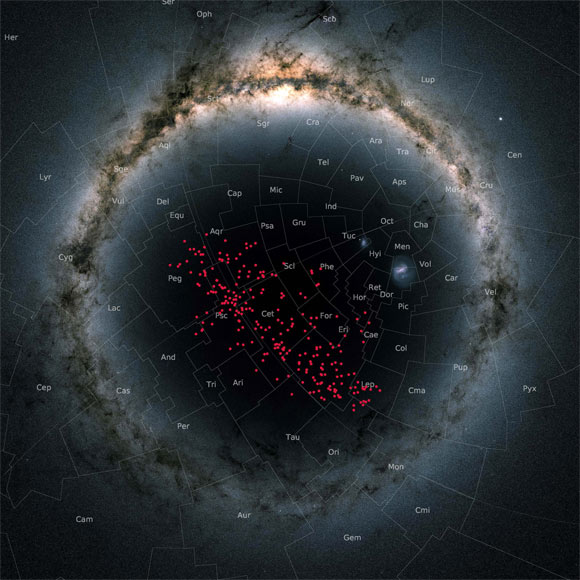Astronomers Discover Large Stream of Stars in Solar Neighborhood | Astronomy – Sci-News.com
Astronomers using ESA’s Gaia satellite have discovered a large stellar stream that is currently traversing the immediate solar neighborhood at a distance of only 326 light-years. The stream contains at least 4,000 stars that have been moving together in space since they formed, about one billion years ago.

Night sky centered on the south Galactic pole in a so-called stereographic projection. In this special projection, the Milky Way curves around the entire image in an arc. The stars in the stream are displayed in red and cover almost the entire southern Galactic hemisphere, thereby crossing many well-known constellations. Image credit: Meingast et al, doi: 10.1051/0004-6361/201834950 / Gaia DR2 skymap.
“Most star clusters in the disk of our Milky Way Galaxy disperse rapidly after their birth as they do not contain enough stars to create a deep gravitational potential well, or in other words, they do not have enough glue to keep them together,” said Dr. Stefan Meingast, an astronomer in the Department of Astrophysics at the University of Vienna.
“Even in the immediate solar neighborhood, there are, however, a few clusters with sufficient stellar mass to remain bound for several hundred million years.”
“So, in principle, similar, large, stream-like remnants of clusters or associations should also be part of the Milky Way disk.”
Thanks to the precision of the Gaia measurements, Dr. Meingast and colleagues could measure the 3D motion of stars in space.
When carefully looking at the distribution of nearby stars moving together, one particular group of stars, as yet unknown and unstudied, immediately caught the eye of the researchers.
It was a group of stars that showed precisely the expected characteristics of a cluster of stars born together but being pulled apart by the gravitational field of the Milky Way.
“Identifying nearby disk streams is like looking for the proverbial needle in a haystack,” said Dr. João Alves, from the University of Vienna and Harvard University.
“Astronomers have been looking at, and through, this new stream for a long time, as it covers most of the night sky, but only now realize it is there, and it is huge, and shockingly close to the Sun.”
“Finding things close to home is very useful, it means they are not too faint nor too blurred for further detailed exploration, as astronomers dream.”
Due to sensitivity limitations of the Gaia observations, their selection only contained about 200 sources.
An extrapolation beyond these limits suggests the stream should have at least 4,000 stars, thereby making the structure more massive than most know clusters in the immediate solar neighborhood.
“As soon as we investigated this particular group of stars in more detail, we knew that we had found what we were looking for: a coeval, stream-like structure, stretching for hundreds of parsecs across a third of the entire sky,” said Verena Fürnkranz, a student at the University of Vienna.
“It was so thrilling to be part of a new discovery.”
The research is published in the journal Astronomy & Astrophysics.
_____
Stefan Meingast et al. 2019. Extended stellar systems in the solar neighborhood. II. Discovery of a nearby 120° stellar stream in Gaia DR2. A&A 622, L13; doi: 10.1051/0004-6361/201834950





